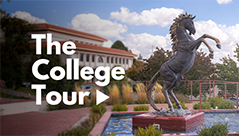For six weeks this summer, WNMU is hosting the Preservation Archaeology Museum and Survey Field School, a joint venture between the university, Archaeology Southwest, and the University of Arizona. Twelve archaeology students from across the country are taking part in the field school, which introduces participants to archaeological analysis and field techniques as well as to the methods and approaches used to interpret archaeological data and apply them to anthropological questions. WNMU Museum Director Danielle Romero and Karen Schollmeyer, who is a preservation archaeologist with Archaeology Southwest, are jointly leading the field school.
As part of the course, students have a chance to visit NAN Ranch, the site of a Mimbres Mogollon pueblo that was excavated in the 1970s and 80s by a team led by Professor of Archaeology Harry Shafer of Texas A&M University. According to Romero, students at NAN Ranch are “redoing the survey that was done in the 70s, and anything else that the landowners want them to take a look at.”
The visit to NAN Ranch is far from the only field trip included in the field school, said Romero. “They will go to Archaeology Southwest’s campsite out in Cliff,” she explained, and “They will do a lot of experimental things: flintknapping, learning to make adobe, learning how [the Mogollon] would have built structures.”
Students in the program also visited Chaco Canyon, El Morro National Monument, El Malpais National Monument, and Zuni and Acoma Pueblos.
While not on field trips, students in the field school spend time at WNMU Museum, engaged in laboratory analysis, museum curation, and their own chosen research projects for the course. The collection of artifacts that were excavated from NAN Ranch is housed by the WNMU Museum, and students in the field school have a chance to work directly with the collection.
The students are also cataloguing the collection. Romero intends to create a thorough, digital catalog of the items held by the museum. “That would make it easier for us to open a public-access version or a more private version for scholars,” she said. “Then a scholar would not have to necessarily come here; they could easily browse through the system, get an idea of what is here” and then decide if they want to travel to Silver City to examine artifacts in person.
Romero said that the field school is different from many others, as it is focused on preservation rather than excavation. “We are more trying to focus on these large collections that have been excavated and to bring new eyes to them,” she said.
Students in the program are also learning practical techniques that will advance their archaeology skills, such as surveying and cataloguing. “Surveying is an important technique to know if you think you want to go the field archaeology route,” said Romero, “You learn how to read a topo[graphic] map, how to use the different materials, how to fill out official site forms for the state.”
Students also had an opportunity to spend two days working with Shafer, who is now retired. Shafer said that it was very rewarding to see the students learning from the collection that he and his team excavated in the1970s and 80s. Said Shafer, “The best experience you can get is hands-on, [The students’] experience handling the pottery and getting to understand Mimbres pottery—what the variability is in it. … They may never work on this pottery again, but the lessons they learn, they can take somewhere else.”
One of the students, Camm Linn, who is a rising sophomore at the University of Missouri, said that the field school was helping to confirm her career direction. “It is helping my conviction that I want to go into museum work,” she said. “After this, I might take an internship or some credit hours at the university archive.”
Another student, Sophie Hood, who attends the University of Vermont, is also interested in a career in museum studies. The field school, she said “is very educational. I feel like I am learning a lot about best practices and about what I want to do. I am much more interested in museums [as opposed to field archaeology]. I am a double major in anthropology and art, and then I have a biology minor. My school does not have a museum studies major, so that is my own version of it. I like natural history museums a lot, so I thought this would be a good experience.”
On the whole, said Romero, the field school is evidence of how much more there is to archaeology than excavation. Students, she said, are “getting a sense of what it is like working in a museum, they are learning to experiment and to survey, so it is more a preservation mentality that reflects the future of archaeology.”



